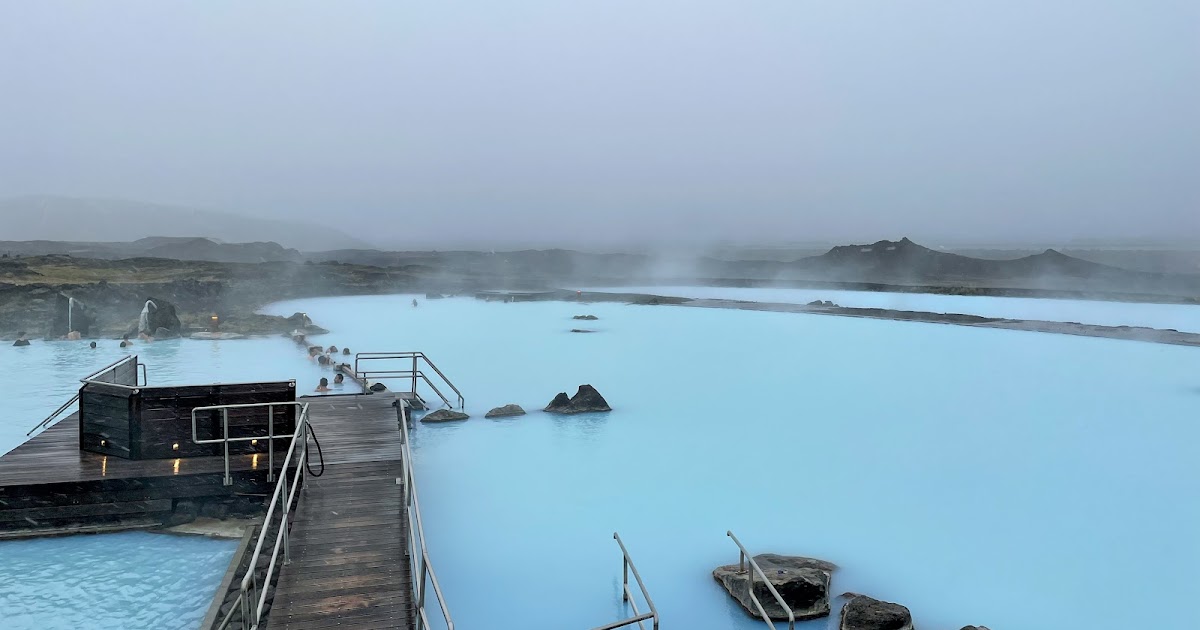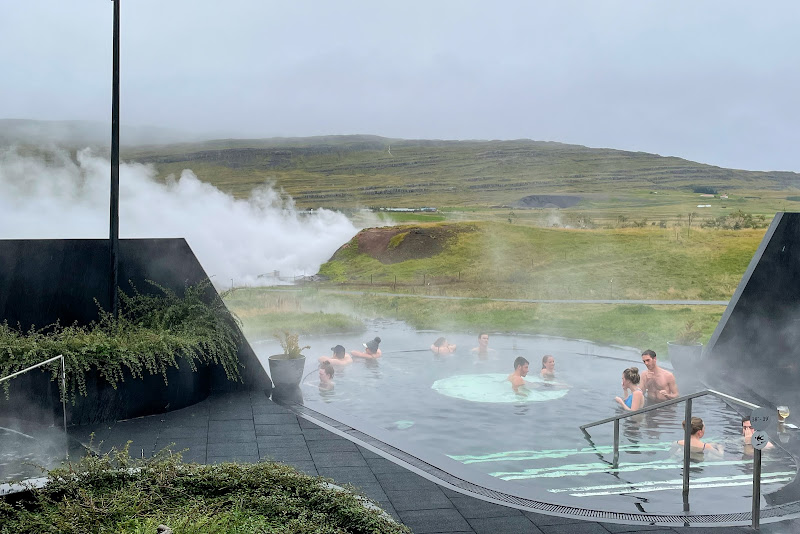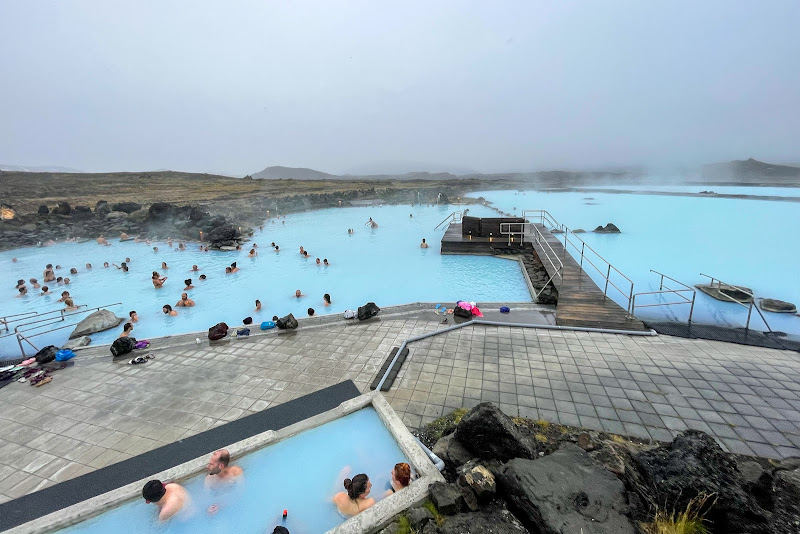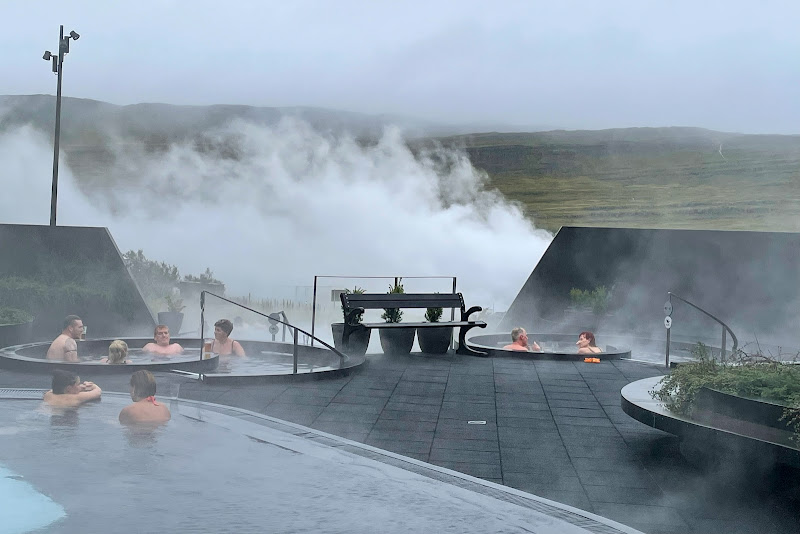So what is a thermal pool, and why does Iceland have so many
of them? Iceland is the land of fire and ice, covered with both volcanoes and
glaciers. One of Iceland’s natural resources is geothermal water, which is used
to fill many of Iceland’s pools in addition to heating Iceland’s homes. Others
are filled with the hot water that is the byproduct of Iceland’s many
hydroelectric power plants.
There are so many geothermal pools and hot springs to choose
from in Iceland, ranging from the very simple to very fancy, so the main
consideration really is which ones are convenient for your Iceland road trip
route. Here are the four geothermal pools we chose for our Iceland road trip.
Blue Lagoon
The Blue Lagoon is Iceland’s most famous geothermal spa. If
you’ve seen pictures of a geothermal spa in Iceland, it was probably the Blue
Lagoon, with a view of a steaming expanse of flat blue waters surrounded by jagged
black lava rock and a woman languidly strolling down the ramp into the afore-mentioned
steaming waters (I’m guessing not on a cold, wintery day where languid outdoor strolling
in a tiny swimsuit is a terribly uncomfortable idea). The Blue Lagoon also gets
a pretty bad rap. The internet is riddled with articles that will tell you that
the Blue Lagoon is horribly touristy and vastly overrated.
We can certainly see how a visit to the Blue Lagoon could be
less than pleasant depending on the circumstances. A visit during summer, in
the middle of the day, when Iceland is teeming with tourists, could be quite
unpleasant if the pools are shoulder-to-shoulder tourists. This is not a
geothermal spa that is a gathering spot for lots of Iceland’s locals. Also, the
Blue Lagoon is one of the most expensive geothermal spas in Iceland. However, based
on our visit, we highly recommend a visit to the Blue Lagoon if the circumstances
are right.
We traveled to Iceland in the middle of September, a time of
year when it is still possible to drive around the island country but is at
the very tail-end of the typical tourist season. Our flight landed at 6:00 in
the morning on a Monday, which meant there would be hours to kill before we
were able to check in to our hotel. The Blue Lagoon is a short 20-minute drive
from Iceland’s Keflavik Airport and sort of on the way to Reykjavik, which was where
we were spending our first night. A visit to the Blue Lagoon directly from the
airport was the obvious choice. We made reservations for 9:00 in the morning, when
the Blue Lagoon opens, which means we were one of the first to arrive.
The Blue Lagoon formed in the lava fields near the
Svartsengi Geothermal Resource Park, which makes the Blue Lagoon unique with its
blue water surrounded by black lava rock covered in green algae. The milky blue
water is due to the silica content, unique to the geothermal waters because of
the lava, and the main ingredient of the silica mud mask that’s included in the
admission price.
We ended up spending almost two hours in the thermal waters
of the Blue Lagoon. We slowly wandered through the multiple areas of the Blue
Lagoon, which have varying water temperatures. We put on our silica mud mask at
the mask bar. We enjoyed our included beverage at the in-water bar (sparkling
water for Romeo, a nourishing smoothie for me). Most importantly, we relaxed
and let the healing waters loosen our travel-weary muscles, while also being out
in the sun to get some much-needed vitamin D to help with the jet lag.
An important thing to remember about the Blue Lagoon, which
is different from Iceland’s other hot springs and geothermal spas, is that the
geothermal seawater’s high levels of silica do not do good things for long
hair. It is important to apply a lot of conditioner to your wet hair and tie it
up in a bun, without rinsing out the conditioner, before entering the water. I did this and had no
negative effects on my hair. It is also important to pre-book your visit.
Krauma Geothermal Nature Baths
Our next Iceland hot spring experience was Krauma, a natural
geothermal bath and spa located at Deildartunguhver, Europe’s largest and most
powerful hot spring. Krauma is just under an hour and a half drive from
Reykjavik and is near one of Iceland’s other natural tourist attractions,
Hraunfossar and Barnafoss waterfalls.
Krauma has five warm baths of varying degrees of heat and
one cold bath. The water is constantly replaced because of the flow of the hot
springs, so there are no extra chemicals in the water. We tried out all of the
warm baths and surprisingly were able to spend about two hours at this spa as
well. Our favorite bath was a shallow concave pool for reclining.
Krauma also has relaxation rooms, a steam bath, an infrared
cell, and a restaurant. It is recommended to pre-book
your visit, but isn’t required.
Mývatn Nature Baths
We visited Mývatn Nature Baths as part of our road trip along
Iceland’s Ring Road. Mývatn is in the northern part of the island and is near many
outdoor attractions. The natural scenery surrounding the lagoon rivals the Blue
Lagoon. The man-made hot spring is supplied with water from the nearby National
Power Company. The geothermal water has a high sulfur content.
Mývatn Nature Baths also has two steam baths and a café. You
can also buy a beer/wine bracelet at reception when you check-in. It is
recommended to pre-book your visit,
but it isn’t required.
ION Adventure Hotel
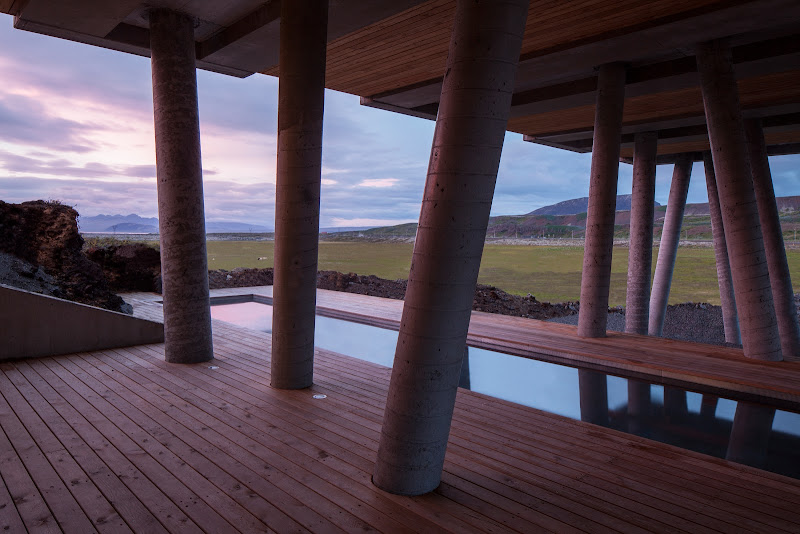 |
| Photo courtesy Design Hotels™ |
Our final geothermal bath experience was at our hotel, the ION Adventure Hotel, for the
Golden Circle portion of our Iceland visit. The ION Adventure Hotel has a
natural spa with a sauna and outdoor hot pool. The hotel is on Mount Hengill, an
active volcano and geothermal energy source for the nearby Nesjavellir Geothermal
Power Station. While the ION Adventure Hotel’s hot pool can’t compete with the
other hot springs and geothermal baths we visited, it was convenient, free, and
just as effective in relaxing the muscles.
Know before you go
There are some things you need to know before visiting
Iceland’s hot springs and geothermal pools.
Prepare to shower naked in front of strangers. It is required
that all guests clean thoroughly before entering the geothermal pools, which
means you have to shower naked. Some spas have a few private showers, but most
showers are communal within the locker rooms, which are separated into men’s
locker rooms and women’s locker rooms.
Lockers are included in the price, and you carry your key
with you, so you can lock your personal belongings up while enjoying the baths.
However, towels are not always included in the price. Do rent a towel if one
isn’t included. Don’t bother with renting a bathrobe. Leave everything in your
locker, including your towel and shoes. You’re spending all your time in the
water and moving around between pools, so having your towel and shoes with you
is more of a nuisance. Also plan on leaving brass or silver jewelry in your
locker, as it could be damaged or discolored by the water.
The locker rooms have body wash, shampoo, and conditioner. There
are also hair dryers. Remember to bring your hairbrush, deodorant, and a hair
tie if you want to put your hair up. Not all spas provide plastic bags for wet
bathing suits, so bring one of those.
